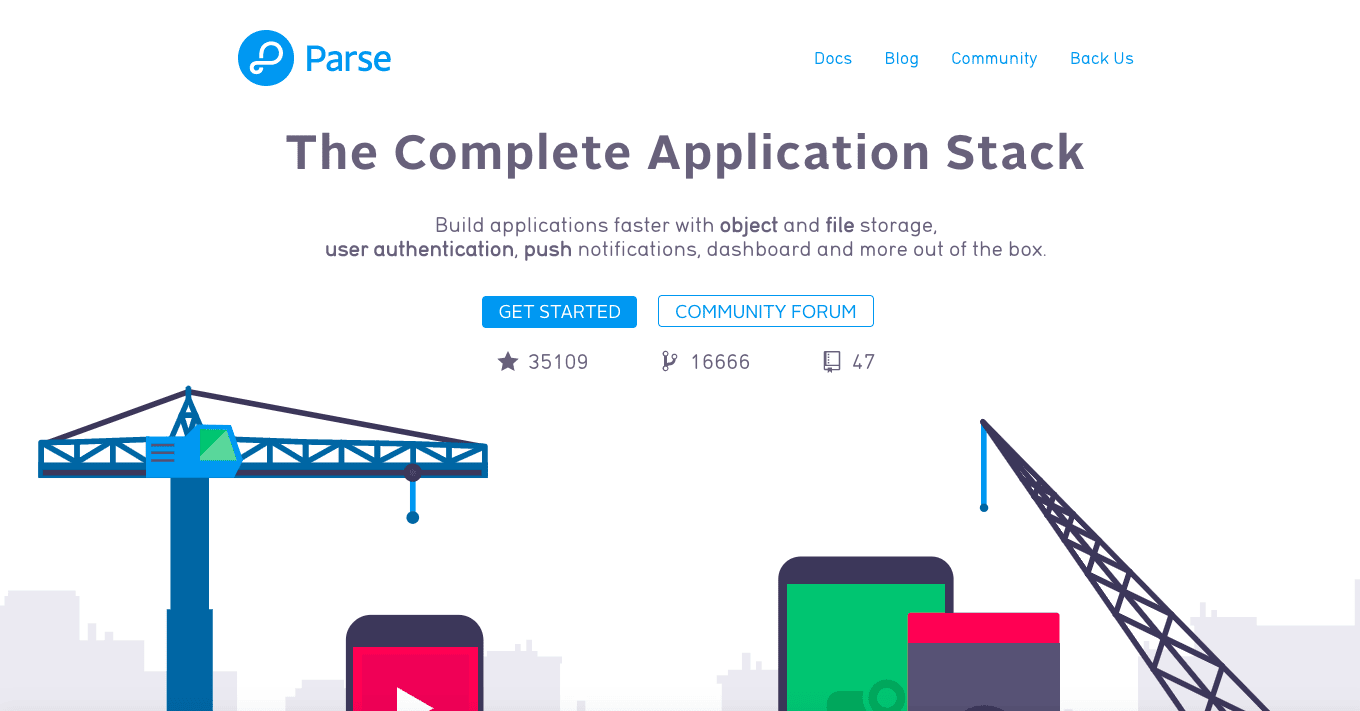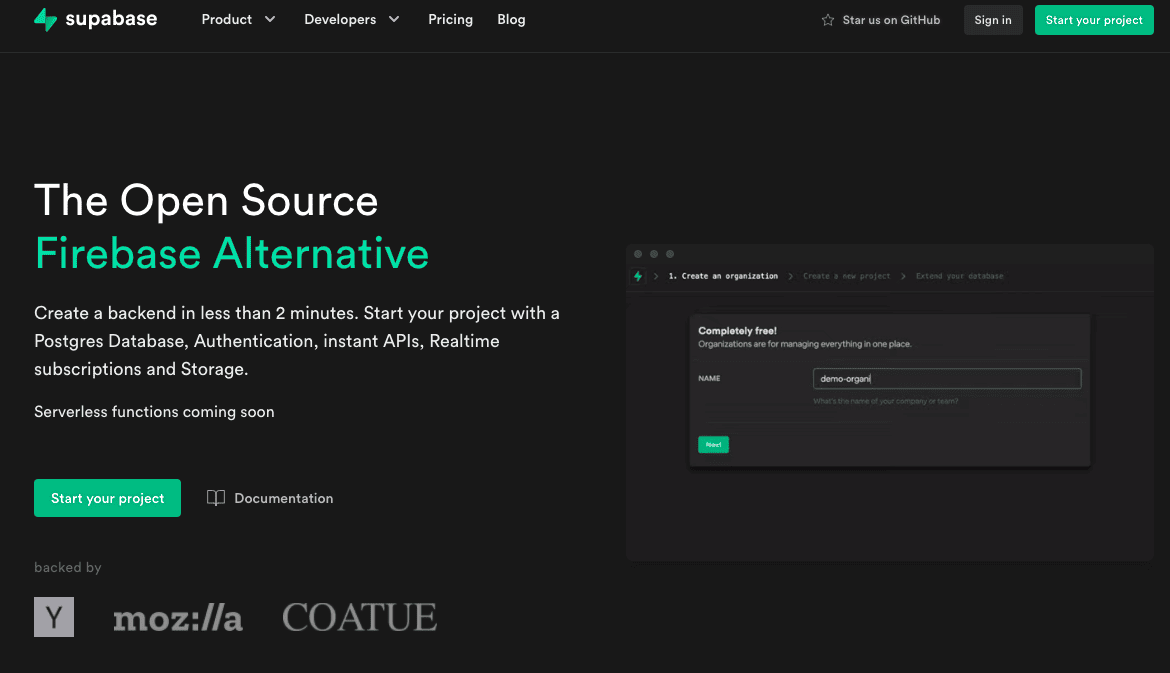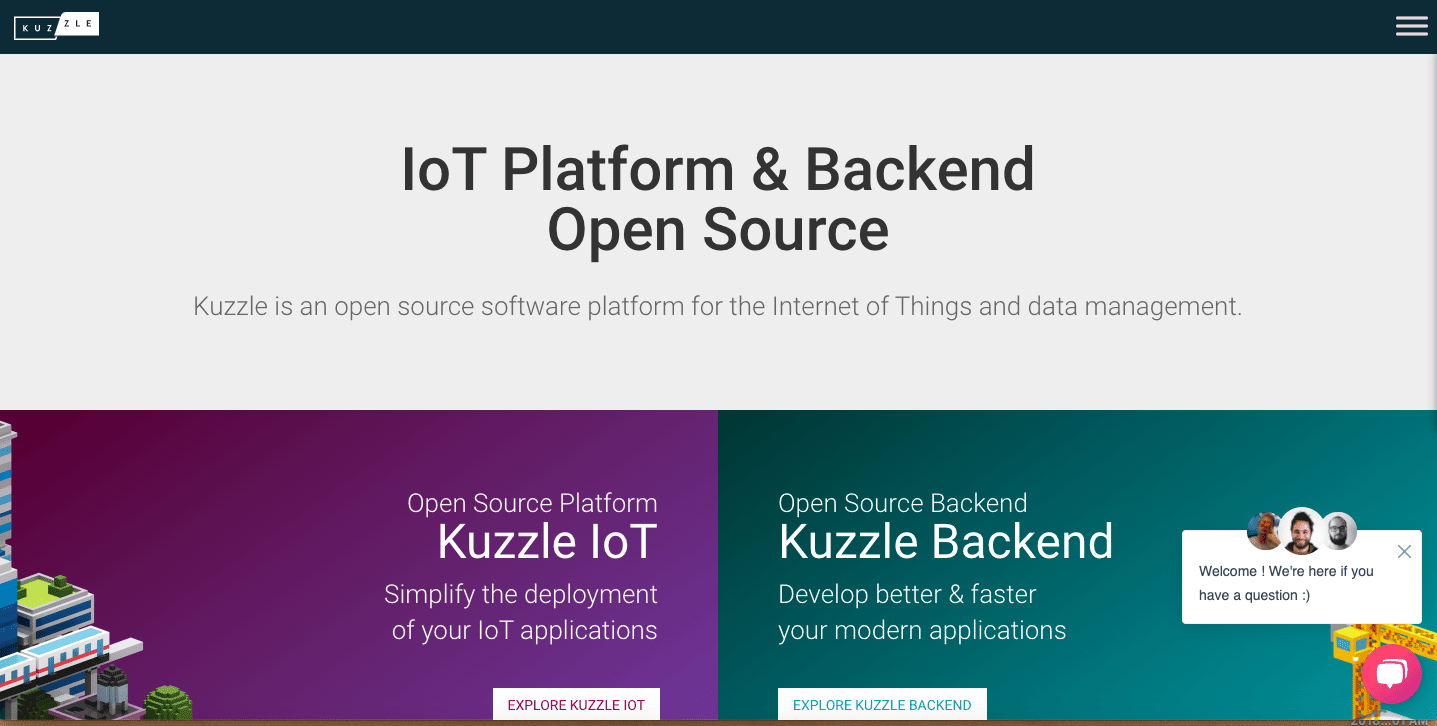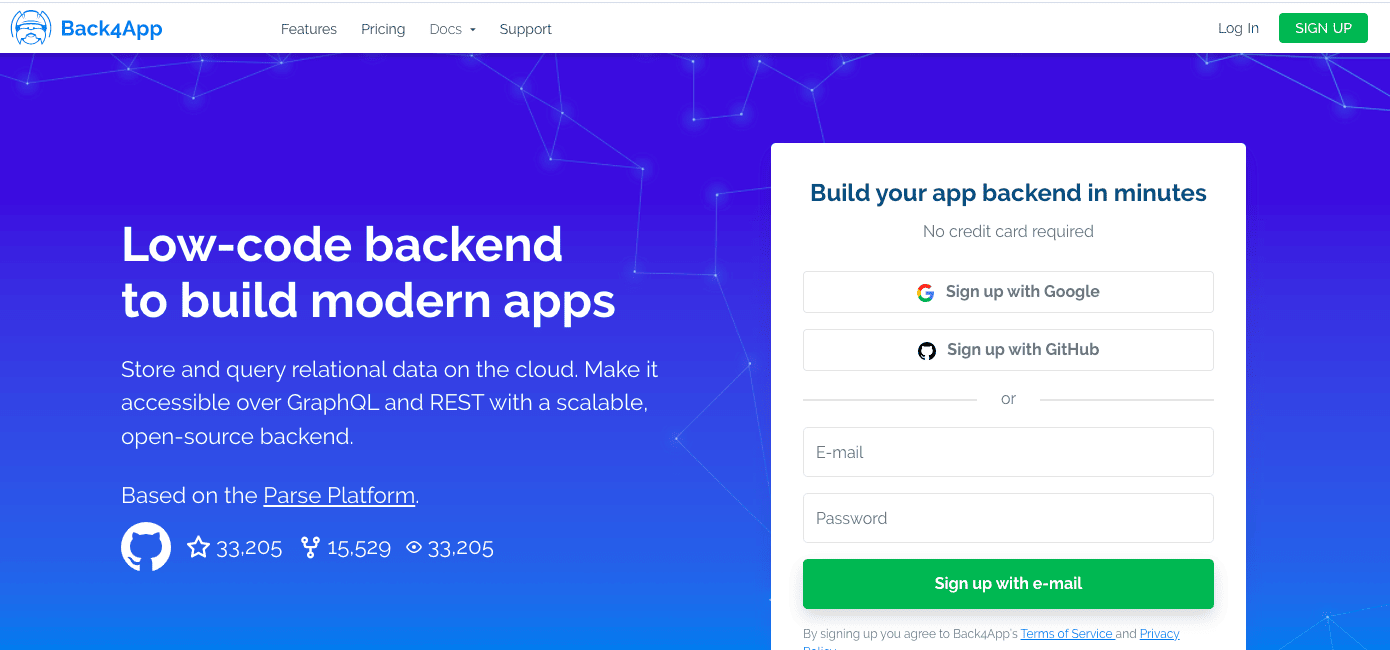Firebase is the default tool for many mobile teams as it assists throughout the entire app development lifecycle, including building, testing, releasing, monitoring, and engaging. Most of its functionality is free, causing many companies to use it without considering whether it’s ideal for their use case.
However, any platform as comprehensive as Firebase is bound to lack advanced features. This might not be a problem for mobile teams that don’t have advanced needs. However, for companies that rely on mobile as a primary touchpoint and revenue source, they will likely find themselves frustrated with Firebase limitations that prevent them from delivering optimized mobile experiences.
So whether you need an alternative to the entire Firebase platform or an alternative to a specific Firebase feature, here’s a breakdown of other tools worth considering.
Alternative BaaS platforms to consider
Firebase is a complete BaaS platform operated by Google, and most of its features are free. Its core features are divided into three parts: Build, Release & Monitor, and Engage, making it a great solution for those that want a single platform for the entire development process.
It’s also designed to scale with your application as your userbase grows. Specifically, you can scale from one user to one million users without changing a line of code.
However, Firebase has some drawbacks that cause companies to look for other BaaS alternatives. Here are a few reasons why users might switch:
- You’re frequently doing complex querying.
- You need your data secured from third parties. (Remember, it’s operated by Google.)
- You require a lot of BI tools.
- You want an open source alternative that enables more flexibility and customization.
- You’ll be performing data migration.
If you’re looking for a Firebase alternative, here are a few other BaaS options to consider.
Parse

Parse is an open source alternative that many people use instead of Firebase because it offers many of the same features and additional benefits.
Parse also runs on any cloud, whereas Firebase only runs on Google Cloud, limiting your options. Users also say that data migrations are much easier with Parse than Firebase. Self-hosting is also free as you can download and run it on any server. In contrast, Firebase users would have to upgrade to the enterprise solution to self-host, which is significantly more expensive.
Supabase

Supabase is another open source alternative to Firebase, and the main difference is that it is a SQL database rather than NoSQL.
Many users love it because it also offers real-time data, authentication for multiple services, file storage, and more. Unlike Firebase, which offers unlimited projects and most of its features for free, Supabase only allows three free projects.
Kuzzle

Like Supabase and Parse, Kuzzle is also an open source Firebase alternative that offers a real-time database.
Kuzzle is known for improving your TTM (time-to-market) as it follows agile processes. In fact, it claims to improve the average user’s TTM by up to 40%.
In addition, Kuzzle offers a scalable server, making it an excellent option for fast-growing apps.
Back4App

Back4App calls itself the “Low-code backend to build modern apps”. It’s based on the Parse Platform, and users say it is an excellent alternative to the original Parse hosting service that Facebook killed.
Back4App users can utilize both GraphQL and Rest API, and its live querying functionality makes it easy to execute real-time sync and storage of data.
Alternatives to individual Firebase services
For many Firebase users, switching to an entirely new platform isn’t necessary. Rather, many mobile teams just need a few advanced features for particular Firebase services.
Here are the core Firebase features:
Below, we’ll discuss each of these services and some alternatives for those that need more advanced options.
Build Services
The Firebase build services are designed for developers building and improving their apps. Many Firebase users love the build services because they make it easy to scale by offering a host of different services, including:
- Authentication
- Emulator Suite
- Realtime Database
- Cloud Firestore
- Storage
- Machine Learning
- Hosting
- Cloud Functions
- Security Rules
- Extensions
Let’s dive into each of these in more detail.
Authentication
Authentication allows you to know who your visitor is to show them a more personalized experience. Specifically, you can have them sign in with passwords, phone numbers, and third-party accounts like Google or Facebook.
To design the sign-in box, you can either create your own interface or use Firebase Authentication’s open source UI to customize an existing template.
Firebase also leaves the user signed in after they leave, making it easier for them to come back and use your app.
However, if you need a different authentication solution, here are some alternatives:
- Auth0 – Excellent for enabling secure, single sign-on.
- MongoDB – Stores data in JSON-like documents.
- Passport – Authentication for Node.js. It’s best for express-based web documents.
- Okta – Customizable, drop-in authentication service that connects all of your apps.
- JSON Web Token – Represents claims securely between two parties.
Emulator Suite
Firebase’s Emulator mimics the behavior of Firebase services to help with integration and QA testing without touching your existing code. However, your app will continue to function normally when the emulators are not configured. You can use it for unit tests, integration tests, and manual tests.
Emulator Suite is a Firebase-specific feature, so if you want an alternative to the Emulator Suite, you would have to select a different BaaS and use their equivalent feature.
Realtime Database
Firebase’s Realtime Database makes it possible to store and share your data on Firebase’s NoSQL cloud database.
It synchronizes your data in real-time, and even if a user goes offline, it will sync their data when they come back online, providing a better user experience. It’s also excellent for teams as it enables them to easily collaborate with one another.
With its security rules, you can specify who can use your data and how the database is structured.
If Firebase’s Realtime Database doesn’t fulfill your needs, here are some other options:
- Oracle Database – Multi-model database management system. Offers both NoSQL and MySQL databases.
- Redis Enterprise Cloud – Designed for performance, scalability, and customization.
- DataStax Enterprise – Real-time analytics at scale. No single point of failure.
- Couchbase Server – Feature-rich NoSQL Database that is easy to use.
Cloud Firestore
The Cloud Firestore allows users to store and sync data for client and server-side development through its NoSQL cloud database. It supports flexible data structures and allows you to perform expressive querying.
For fast growing companies, Cloud Firestore is designed to scale with your needs, claiming it can handle “the toughest database workloads from the world’s biggest apps”.
All data is provided in real-time, allowing users to view current data on any connected device.
If you’d like to compare it with some alternatives, here are a few options to consider:
- MongoDB Atlas – Highly scalable across multiple platforms.
- Amazon DynamoDB – Flexible NoSQL database service that delivers single-digit millisecond performance.
- Oracle Database – An RDBMS with object-oriented features.
- Azure CosmoDB – Also a fully managed NoSQL database designed for scalability.
Cloud storage
Cloud Storage allows users to store user-generated content like videos, photos, and more. It uses the Firebase SDK and implements Google’s security to any uploaded file to ensure the data is secure.
Firebase’s Cloud Storage is also highly scalable and can handle dramatic volume increases (e.g., if your app goes viral). Another benefit is that it can perform uploads and downloads on virtually any network connection.
If you’d like to see some alternatives to Cloud Storage, check out these options:
- IBM Db2 – Elastic cloud data warehouse.
- CloudFlare – Rapid and reliable object storage.
- BunnyCDN – Lightning-fast CDN designed to scale.
Machine learning
Firebase’s Machine Learning solution is a mobile SDK for engineers that want to incorporate machine learning into their iOS and Android apps. It’s currently in Beta.
It’s user-friendly, and anyone can use it, as you only have to understand neural networks or model optimization to implement it.
With Firebase’s machine learning capabilities, you’ll be able to host and deploy custom models, train those models, and then test them to ensure they are production ready.
If you want some alternative options, you can check out these options:
- Amazon machine learning – Excellent for deadline-sensitive operations.
- Azure machine learning – A web-based and low-code environment.
- Google AI platform – A collection of Google tools including AI Platform (Classic), AutoML, frameworks, and APIs.
- IBM Watson machine learning – Comprised of several tools, including AutoAI, SPSS Modeler, and Deep Learning.
Hosting
Firebase Hosting is production-grade web content hosting that serves both static content such as HTML and CSS and dynamic content like Express.js microservices and APIs.
It is also very secure as it uses a zero-configuration SSL, which is the industry-standard HTTPS Encryption. Another reason why many users love Firebase’s hosting is because it automatically selects the best compression method for your content to ensure it is always delivered quickly.
Users can also test any changes on an emulated backend with a locally hosted URL.
If you still want some alternatives, here are a few ideas:
- Heroku – Cloud PaaS that makes it easy to build, run, and operate applications,
- DigitalOcean – Simple, affordable cloud hosting,
- Kumulos – mBaaS that enables backend cloud-based storage,
Cloud functions
For companies that don’t want to manage their own servers, Firebase’s cloud functions might be a great solution as they allow you to store JavaScript and TypeScript in Google’s cloud.
It is a serverless framework that enables developers to run backend code in response to events triggered by HTTPS requests or other Firebase triggers. It also requires zero maintenance as it is designed to scale resources to automatically match users’ usage patterns.
If you’re already using other Firebase features, it’s a great option, though here are some alternatives if it doesn’t work for you:
- Google Cloud Functions – Serverless execution environment that connects cloud services.
- AWS Lambda – Run code without servers or clusters.
- Cloudflare Workers – Quickly deploy serverless code.
Security rules
If you’re using Cloud Firestore, Firebase Realtime Database, or Cloud Storage, you can use Firebase’s Security Rules to secure that data. It’s flexible so that developers write custom rules and use their own code to authorize access, making it even more secure.
Developers also have full control over the granularity of each security rule.
Best of all, it uses independent security, meaning you aren’t responsible for enforcing and securing data. If you aren’t satisfied with Firebase’s security rules, you’ll have to purchase another BaaS platform altogether as you can’t really purchase an alternative to Firebase’s security rules.
Extensions
Firebase defines its extensions as “code that performs a task whenever a specifically defined event occurs in your app or project”.
This means they are third-party tools that aren’t built or tested by Google, though they can be useful for improving your app’s development.
Here is a list of all the official Firebase extensions.
Release & monitor services
Rolling out a poor version of your app can be detrimental to the customer experience and your brand’s image. That’s why Firebase offers a host of different options to identify issues faster and improve your release process.
Its main features include:
- Crashlytics
- Performance Monitoring
- Test Lab
- App Distribution
Here’s a detailed look into each feature, along with alternatives for those that need more advanced functionality.
Crashlytics
Crashlytics is a lightweight crash reporting tool that gives developers a basic overview of each crash, such as the estimated number of users affected by the crash and its severity.
It also allows you to set up basic alerting for crashes.
However, it often lacks the data necessary to solve the crash because it uses a sampled dataset. Therefore, mobile teams cannot drill down to the complete details of affected user sessions for a clear path toward resolution.
Without granular data, this means engineers will waste time finding a solution. So if flawless mobile performance is important for your company, read more about various Crashlytics alternatives.
Performance monitoring
Firebase’s performance monitoring lets you see metrics like startup time, network requests, and more. It works with Android, iOS, and web apps, making it a popular choice for many developers. You can also see metrics for specific countries, devices, app versions, and more.
However, because Firebase samples all data, you won’t be able to see much beyond aggregate metrics.
This is a problem because mobile teams struggle to understand the impact of slowdowns across key user segments (e.g. high-value users) in addition to lacking actionable data to pinpoint the underlying root cause.
If you need more visibility into your mobile app performance, consider using Embrace.
Embrace allows developers to view every session of every user to fully understand the experience your app provides.
This means you can track every performance and stability metric, including their distributions across features, versions, and user segments, and have the complete context needed to prioritize and solve any regression. For example, check out this post on our revolutionary ANR stack trace flame graph functionality that redefines how mobile teams can address ANRs that impact their retention, revenue, and discoverability.
Test lab
Before releasing your app to the public, you can use Firebase’s Test Lab to simulate various scenarios it may encounter with real users.
The test lab is suitable for both Android and iOS, and it runs on real devices to ensure it works on various devices and configurations.
It also offers customizable locale settings to ensure your app is ready for real-world users.
If you want a different test lab, here are a few other options:
- Sauce Labs – iOS, Android, and mobile games testing lab from development to production.
- Perfecto.io – Cloud based mobile testing lab.
- Micro Focus – Develop, debug, test, monitor, and optimize mobile apps in an omnipresent lab.
App distribution
If you want to test your app on a selected group of real users, you can use the Firebase App Distribution to do an early release to those testers.
It gives you control to manage your test groups by adding new testers, viewing the status of a specific test, and checking statistics on which users accepted your testing invitation.
If you’re using Crashlytics, the data from App Distribution will be available in the Crashlytics report so that you can quickly view stability metrics from each test.
If you want a different app distribution tool, here are a few alternatives:
- TestFlight – Owned by Apple, for iOS only.
- TestFairy – Owned by Sauce Labs and supports Android and iOS.
Engage services
Once your app is live, Firebase helps you optimize it to ensure users have a high quality experience. Specifically, you can run A/B tests, analyze detailed analytics, and even monetize your app.
Below, we’ll cover each feature in detail as well as some alternatives.
Google Analytics
Google Analytics is one of the most popular analytics tools on the market as it offers powerful insights into how your app is performing and user engagement patterns.
This helps your company better understand which users are highest value (e.g. generate the most revenue) so they can optimize the app to better suit those users’ needs.
When you log into the dashboard, you’ll see that it automatically captures a variety of events and user properties, though you can also create custom events if necessary.
It works with Android, Apple, and web apps, and allows users to create unlimited reports for 500 distinct events defined with the Firebase SDK.
If you’re looking for some alternatives to Google Analytics, here are a few options:
- Mixpanel – Simple mobile app analytics with pre-built dashboards.
- Amplitude – Product intelligence platform that provides digital product tools that help teams run and grow their businesses.
- Woopra – Analytics geared towards mobile games.
- Heap Analytics – Analytics infrastructure to reduce the annoying parts of user analytics.
Remote Config
If you want to change the behavior or appearance of your app, but you don’t want to make users download an app update, you can use Firebase’s Remote Config.
Remote Config offers an audience segmentation feature that makes it easy to A/B test various aspects of your app. For example, if you offer a game and are debating increasing the difficulty level, you can push a difficult and easier version out to separate audiences.
Remote Config is also useful for showing personalized content. For example, if you want more positive reviews, you could set the app to prompt only customers who use the app daily to leave a review.
If you want a different Remote Config solution, here are some other options:
- LaunchDarkly – Great for enterprise companies (security is reserved for Enterprise plans).
- Optimizely – Best if you want A/B testing features included in the plan (not as an add-on).
Firebase A/B Testing
Firebase’s A/B testing solution runs on top of Remote Config (to test various changes to the app’s interface/build), Cloud Messaging (to test different notification messages), and Analytics.
You can segment testing groups based on geography, language, and more.
Once you’ve created a testing group, you can track variables like shares, user retention, revenue, and more.
If you want a different A/B testing solution, here are some alternatives to consider:
- Optimizely – Designed for e-commerce stores and product focused apps.
- Applause – Functional, localization, and usability testing with over 400,000 experienced testers.
- VWO – Server-side and mobile app A/B testing for iOS and Android.
Cloud messaging
If you want to improve user retention and engagement, sending notifications is a great way to bring them back to the app.
Cloud messaging makes it simple to send messages to your users, and it scales easily, as Firebase claims it sends billions of messages per day that arrive in less than 250 milliseconds 95% of the time. You can also easily create custom segments for sending messages to specific groups of people.
If you want a different notification and messaging platform, here are a few other alternatives:
- OneSignal – Advanced analytics, segmentation, and messaging automation.
- Amazon SNS – Fully managed pub/sub messaging, SMS, email, and mobile push notifications.
- Kafka – Best for event-driven systems and streaming analytics.
Dynamic links
Deep links were originally designed to bring people directly to the content they clicked instead of landing them on your website or app’s home screen. However, their inherent complexity means they aren’t always reliable.
For example, they might break depending on the user’s device, connectivity, link, or whether or not they had already downloaded the app.
That’s why Firebase offers Dynamic Links. Dynamic links work the way deep links were supposed to work. In other words, you can have a single URL that will provide content that is designed for whatever device type the user is on (desktop, Android, or iOS).
A single dynamic link can also recognize which users have and have not downloaded your app. For users that have your app installed, the link will take them directly to the screen they want to access.
On the other hand, if they don’t have your app installed, it will prompt users to download your app. Better yet, once the app is downloaded, it will continue to the specific screen they originally clicked into for a better user experience.
If you want some alternative options to Firebase’s Dynamic Links, check out these tools:
- Branch.io – Deep linking technology used to gain and retain mobile app users.
- Shorten.REST – More advanced version of Firebase’s Dynamic Links.
- GetSocial – Ideal for users that offer a lot of links through social media.
- Kochava – Full mobile app attribution and analytics suite.
Google AdMob
Google AdMob makes it easy for businesses to monetize their app by showing affiliate ads and assisting you in generating more in-app purchases.
To maximize affiliate revenue, AdMob can determine which ads pay the most and show them in your app more often. It can also predict which users are more likely to make an in-app purchase and show them an offer at the most opportune moment.
In terms of customization, it allows you to create CSS templates to ensure the ad formats fit within your designs.
If you want an alternative to AdMob, here are a few products that do something similar:
- Unity Ads – Primarily for mobile games.
- AppLovin – Easy to set up and users report it is one of the highest-earning platforms.
- ironSource – Empowers any developer to monetize their app.
- Vungle – Heavy emphasis on the creativity of ads and customization.
Google Ads
Google Ads is one of the most popular products Google offers and many mobile apps use it to drive installs, retarget visitors, and more.
You can also export audience lists to Google Ads to improve your targeting and generate more conversions.
Google Ads also integrates nicely with Google Analytics to easily see conversions and identify common behavioral patterns of your top customers.
Here are a few alternatives to Google Ads:
- Microsoft Ads (previously Bing ads) – If you want to run ads on Bing, this is their native ad platform.
- Amazon Ads – If you want to run ads on Amazon, this is their native ad platform.
- AdRoll – If you want a tool that lets you manage all of your ads in one place, this is the best solution.
Finding the right alternative for your needs
Firebase covers just about everything you need to build, launch, and grow your app. However, its large featureset means that many individual services lack crucial functionality that mobile teams require to make the best business decisions.
That’s why many users adopt Firebase as their go-to platform and supplement its coverage with additional third-party services.
One such example is Embrace. We’re a data driven toolset to help mobile engineers build better experiences. We provide mobile teams with the data and insights needed to deliver seamless user experiences.
We provide 100% of the data from 100% of user sessions so that mobile teams can quickly identify, prioritize, and solve any business-impacting issue.
When companies rely on Firebase for optimizing the performance and stability of their mobile applications, they frequently lack visibility to make key business decisions. To see how Embrace can help your company deliver flawless mobile experiences, schedule a demo today.
The most important thing is to make tooling decisions based on how they can help you achieve your business goals. In this post, we’ve highlighted several alternatives to Firebase and its individual services so that you have a great starting point when deciding which tools can best help you grow your mobile initiatives.
Get started today with 1 million free user sessions.
Get started free
